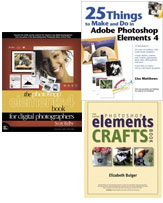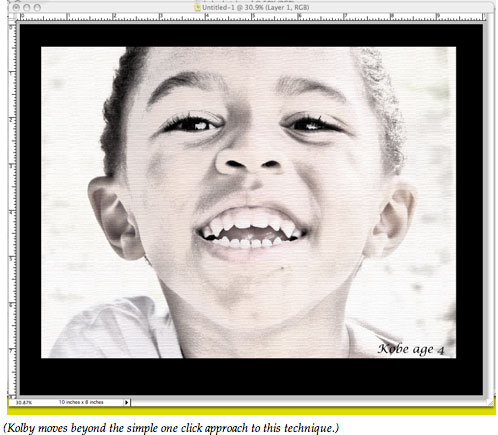
The Photoshop Elements 4 Book for Digital Photographers,
By Scott Kelby
ISBN 0-321-38483-0
$34.95 CN $48.99 £24.99
25 Things to Make and Do in Adobe Photoshop Elements 4,
By Lisa Matthews
ISBN 0-321-38481-4
US $34.99 CN $34.99 £17.99
The Adobe Photoshop Elements Book,
by Elizabeth Bulger
IBN 0-321-36896-7
Peachpit Press
http://peachpitpress.com
I took a class in digital photography this semester and while the instructor is a knowledgeable and experienced photographer and Photoshop user, he was most challenged by teaching us his students how to use Photoshop. Many students either couldn’t keep up with his demonstrations, or he showed rather taught us digital “darkroom” techniques as we passively sat watching him having all the fun.
As I reflect back on his class, I think how useful it would have been for this instructor to use one of Scott Kelby’s Photoshop how-to books for his course. As editor and chief of Photshop User magazine, President of the National Association of Photoshop Professionals, and (as if that’s not enough) Executive Editor of the Photoshop Elements Techniques newsletter, Kelby’s books are a large collection of techniques, typically explained in two to three pages each.
(By the way fellow Mac users, though the books under review have Photoshop Elements 4 in their title, and though Adobe has so far dissed us by excluding us for its latest PE update, there are still many techniques and projects presented in these books that could be done on PE2 or 3. In the meantime, we need to write Adobe and remind them to come correct. )
One of his latest books, The Photoshop Elements 4 book contains well over a hundred techniques to help you improve and manipulate your digital photos. The beauty of the book is that all the examples are in full color and if need be you can download the included photos from the book’s companion website to use for the exercises. Kelby’s witty and direct style make his step-by-step instructions easy to understand and apply.
Kelby’s a bottom line Photoshop user. He cuts to the chase pointing out the short key cuts and the little tips and tricks typically regulated to the side bars of many other how-to Photoshop books.
This is not a book you read from beginning to end. It’s one that you flip through and say, I want to try that, or I need to do this one to improve my photos. If you’re new to PE, he shows you how to get your digital negatives from your camera to the application. He follows up this tip showing you how to sort, tag, and present your digital photos. Granted some of these techniques like tagging photos are features available only in PE4, but hey we Mac users have iPhoto (and now Aperture) for all our digital organizing and management needs.
Many of the most useful techniques for those in the photo making business include the following: cropping and resizing, drag-and-drop instant color correction (a cool little time saver), adjusting flesh tones, digital dodging and burning, saving selections, removing or lessening wrinkles, doing digital nose jobs, cloning away unwanted objects, replacing the boring sky with a more dramatic one, creating a simple depth-of-field effect, turning a photo into a drawing (see mine below), colorizing black-and-white photos, retouching old photos, watermarking and adding copyright info, creating a digital frame, and putting your photos on the web. Kelby gives a brief introduction to each technique and then literally explains it step by step. There’s no wasted language, though he does explain as part of some steps why certain tools are used to achieve particular outcomes. I also notice that Kelby alludes to which techniques apply specifically to PE 4, but if you really rather have a book that addresses only the first three PE versions, you could always buy the previous edition of this book.)
Professional photographers working with digital photography will be pleased with how Kelby includes techniques applicable to client-based work. This is not an how to buy or use a digital camera book. He doesn’t talk about f-stops, composing a shot, or lighting a studio. He focuses on digital darkroom processing, retouching and manipulation from the perspective of working professional photographers and serious amateurs alike.

Project Based Photoshop Elements Books
Another useful way for better understanding and using PE is through doing specific projects. Elizabeth Bulger’s The Adobe Photoshop Elements Craft Book, and Lisa Matthews’s 25 Things to Make and Do in Adobe Photoshop Elements 4 present some very creative ways to make use of your digital photos.
These books of course are not manuals for the application, but I bet that even new users to PE could learn the application with one of these books. Each author starts off explaining fundamental tools of using PE like how layers work, how to make selections, and a basic understanding of resolution, especially in relationship to printing photos.
For those already familiar with these basics, you can flip through the pages and find in Bulger’s book how to use your photos to create a folding postcard, a Gingham gift box, an anniversary votive, a cover for a journal, a pet place mat, a travel photo CD cover (see mine below), and Christmas ornaments.
Lisa Matthews includes projects for creating panoramic images, making unique boarders, laying out a recipe book, making your won custom stationery, creating party banners, T-shirt designs, and CD or DVD labels. Many of her projects, like making a photo calendar, are particular to new features in PE4, but the ideas can still be pretty well accomplished in any version of Elements. (When these authors say, for example, Press the Ctrl key, they’re referring to PC users. In the case of using Macs, use the Command key.)

With each project you will no doubt learn a new tool or technique. For instance, in completing the holiday wrapping paper project (Bulger’s book), I learned the use of the Fill Layer and how to create and custom brush. Completing this and other projects you’ll learn how to resize photo, use selection tools, add a boarder, use the Custom Shape tool, mask an image inside a piece of text (see my example below), use the eye dropper, etc. In fact, it would be nice to have a “what tools will be learned” listed at the beginning of each project.

It’s well known that Photoshop Elements can do about 80% of what the larger, more expensive Photoshop CS can do. All three of these books, help you get the most out this powerful and affordable program.

Leave a Reply
You must be logged in to post a comment.